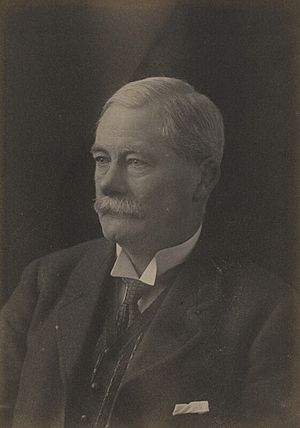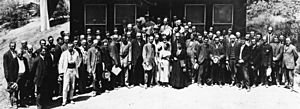Herbert Hall Turner facts for kids
Quick facts for kids
Herbert Hall Turner
|
|
|---|---|
 |
|
| Born | 13 August 1861 Leeds, England
|
| Died | 20 August 1930 (aged 69) Stockholm, Sweden
|
| Awards | Bruce Medal (1927) |
| Scientific career | |
| Fields | |
Herbert Hall Turner (born August 13, 1861 – died August 20, 1930) was a British astronomer and seismologist. This means he studied both stars and planets, and also earthquakes. He was known for discovering a special type of earthquake and for helping to name the dwarf planet Pluto.
Contents
About Herbert Hall Turner
Herbert Hall Turner went to school in Leeds and Bristol, and then to Trinity College, Cambridge University. In 1884, he started working at the Royal Greenwich Observatory as a Chief Assistant. This was an important job helping with observations and research. He worked there for nine years.
In 1893, he became a professor of astronomy at Oxford University. He was also the Director of the Radcliffe Observatory there. He held these important positions for 37 years until he passed away in 1930.
Turner was part of special trips to observe solar eclipses in 1886 and 1887. These trips helped scientists learn more about the Sun and space.
Discoveries and Contributions
In the field of seismology (the study of earthquakes), Herbert Hall Turner is famous for finding deep focus earthquakes. These are earthquakes that happen very far down inside the Earth, much deeper than most earthquakes.
He is also given credit for inventing the word parsec. A parsec is a unit of distance used in astronomy. It's a huge distance, equal to about 3.26 light-years. Scientists use it to measure how far away stars and galaxies are.
Turner also helped write the first official history book about the Royal Astronomical Society. This book, called History of the Royal Astronomical Society 1820–1920, was published in 1923.

Naming Pluto
A few months before Turner died in 1930, the Lowell Observatory in the United States announced they had found a new planet. An eleven-year-old schoolgirl named Venetia Burney from Oxford suggested the name "Pluto" for it. She told her grandfather, who then passed the idea to Professor Turner. Turner quickly sent a message to his colleagues at the Lowell Observatory. The new planet was officially named "Pluto" on March 24, 1930.
Herbert Hall Turner passed away in 1930 from a brain hemorrhage while attending a conference in Stockholm, Sweden. He was married to Agnes Margaret Whyte and they had one daughter, Ruth.
Achievements and Recognition
Herbert Hall Turner received many honors during his life for his important work in astronomy and seismology.
Awards and Lectures
- He was awarded the Bruce Medal in 1927, which is a very important award for astronomers.
- In 1913 and 1915, he was invited to give the Royal Institution Christmas Lectures. These are famous science lectures for young people. His talks were called A Voyage in Space and Wireless Messages from the Stars.
Named After Him
- There is a crater on the Moon named Turner in his honor.
- An Asteroid called 1186 Turnera is also named after him.
His Work
You can read one of his books, Astronomical Discovery, which was first published in 1904.
See also
 In Spanish: Herbert Hall Turner para niños
In Spanish: Herbert Hall Turner para niños

